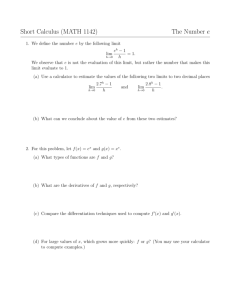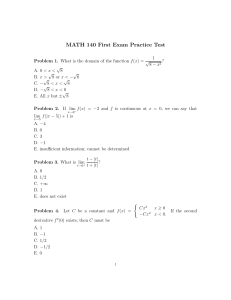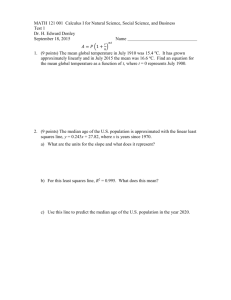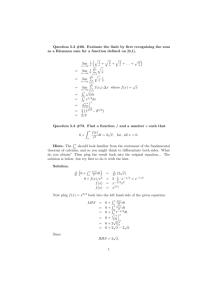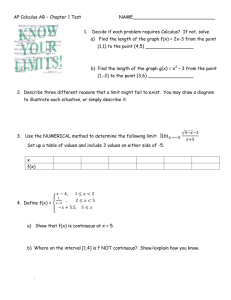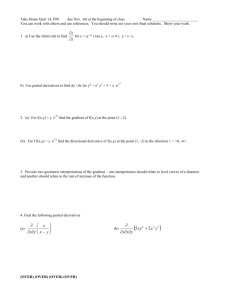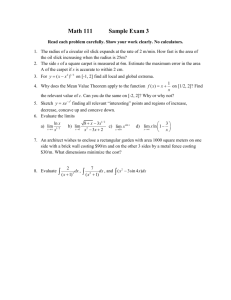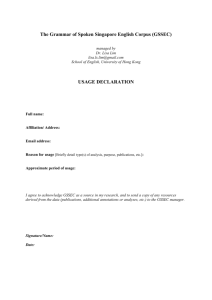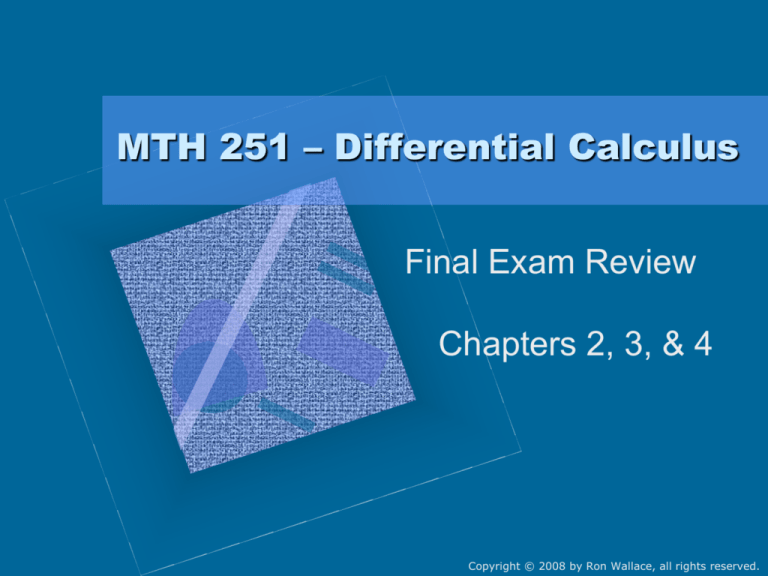
MTH 251 – Differential Calculus
Final Exam Review
Chapters 2, 3, & 4
Copyright © 2008 by Ron Wallace, all rights reserved.
MTH 251 – Differential Calculus
Chapter 2 Review
Limits and Continuity
Copyright © 2008 by Ron Wallace, all rights reserved.
Calculating Limits - 1
lim f ( x )
x c
• Polynomial: f(c)
• Rational: f(c) if there is
no division by 0
• Radical: f(c) if there are
no even roots of
negatives.
• Exponential: f(c)
• Logarithmetic: f(c) if
there a no logs of nonpositives
• Trigonometric: f(c)
except where the trig
functions are undefined.
• Sums, Differences,
Products, Quotients
(except division by zero), and
Compositions of these.
Calculating Limits - 2
lim f ( x )
x c
• Algebraic equivalences.
If f(c) has a problem & f(x) = g(x),
then try g(c).
Calculating Limits - 3
lim f ( x )
x c
• Two “estimates” (aka: reasonableness checks)
Graph: w/ calculator or software
Values: f(a) where a is “near” c
Calculating Limits - 4
lim
xc
p( x )
q( x )
when p( x) m & q( x) n
m & n finite
m or n infinite
• m = 0, n 0: 0
• m = , n : ±
• m 0, n = 0: ±
• m , n = : 0
• m = 0, n = 0: ?
• m = , n = : ?
NOTE: If m & n are finite and not zero, then the limit is m/n.
Proving Limits
• Definition
lim f ( x ) L
x c
f(x)
L+
if, for every number > 0,
there exists a number > 0
such that …
0 xc
f ( x) L
L
L-
c- c c+
You MUST be able to state this & draw the diagram w/ labels.
Proving Limits
• Process …
Begin with f ( x) L
• i.e.
f ( x ) L
lim f ( x ) L
x c
may or may
not be given
Manipulate to get … a x c b
Determine
• If a x c b a , then b
• If a x c a b , then a
note: a 0 & b 0
One Sided Limits
lim f ( x )
xc
• Left-Hand Limit
• Only need to
consider x < c
lim f ( x )
xc
• Right-Hand Limit
• Only need to
consider x > c
Limits as x ±
lim f ( x )
x
• x decreases without
bound
Essentially a righthand limit.
lim f ( x )
x
• x increases without
bound
Essentially a lefthand limit.
Limits as x ±
lim
x
p( x )
q( x )
• Same degree …
Limit is the ratio of the leading coefficients
• Numerator w/ smaller degree …
Limit is zero.
• Denominator w/ smaller degree …
Limit is ± (sign to be determined)
When a limit DNE
lim f ( x ) DNE
x c
• f(x) is not defined around c
• Jump
Usually a piecewise function
• Oscillation
Usually involves sine or cosine
• Increase/Decrease without bound
May be different on left and right
Continuity
• f(x) is continuous at x = c if and only if …
When c is an interior point of the domain and
lim f ( x ) f ( c )
x c
When c is a left endpoint of the domain and
lim f ( x ) f ( c)
x c
When c is a right endpoint of the domain and
lim f ( x ) f ( c)
x c
NOTE: You MUST be able to state this definition.
Common Points of
Discontinuity
• f(c) is not defined
• The limit as x c DNE
• Both of the above
• f(c) does not equal the limit as x c
Continuous Functions
• A function that is continuous for all
values of its domain.
• All of the “elementary functions” are
continuous functions.
polynomials, rationals, radicals,
exponentials, logarithms, absolute values,
trigonometric, and combinations of these
note: Consider the domains.
Intermediate Value
Theorem
• If f(x) is continuous over [a,b] and k is
any value between f(a) and f(b), then
there exists at least one number c in
[a,b] where f(c) = k.
• Problem … find a c given k, f(x), & [a,b]
Derivatives
f ( x0 h ) f ( x0 )
lim
h 0
h
• Find a derivative.
• Use a derivative to determine the
equation of a line tangent to a curve at a
given point.
NOTE: You MUST be able to state this limit.
MTH 251 – Differential Calculus
Chapter 3 Review
Differentiation
Copyright © 2008 by Ron Wallace, all rights reserved.
Definition of the Derivative
f ( x h) f ( x)
f ( x x ) f ( x )
f ( z) f ( x)
f '( x ) lim
lim
lim
h 0
x
0
z x
h
x
zx
• Any one of the three limits will do.
Given the graph of a
function …
• Determine the values of x where …
the derivative exists or does not exist
the derivative is zero
the derivative is positive
the derivative is negative
Part 1 of 2
Differentiation Rules
d
c 0
dx
d 1
1
2
dx x
x
d
dx
d n
x nx n 1
dx
x 21x
d
cf ( x) cf ' ( x)
dx
d
f ( x) g ( x) f ' ( x) g ' ( x)
dx
d x
e e x
dx
d
1
ln x
dx
x
d
f ( x) g ( x) f ' ( x) g ( x) f ( x) g ' ( x)
dx
d
e f ( x ) e f ( x ) f '( x )
dx
d
f '( x )
ln( f ( x))
dx
f ( x)
d f ( x) f ' ( x) g ( x) f ( x) g ' ( x)
dx g ( x)
g ( x)2
d
a x a x ln a
dx
d
1
loga x
dx
x ln a
d
f ( g ( x)) f ' ( g ( x)) g ' ( x)
dx
Part 2 of 2
Differentiation Rules
d
sin x cos x
dx
d
cos x sin x
dx
d
tan x sec2 x
dx
d
sec x sec x tan x
dx
d
csc x csc x cot x
dx
d
cot x csc 2 x
dx
d
1
d
sin 1 x
cos 1 x
2
dx
dx
1 x
d
1
d
tan 1 x
cot 1 x
2
dx
1 x
dx
d
sec 1 x
dx
x
d
f
dx
1
1
x2 1
( x )
d
csc 1 x
dx
1
d
f ( x )
dx
f
1
( x)
Using Derivative Rules
• Determine the derivative of a function
• Use the derivative to find …
the equations of the tangent and normal lines to a
function at a given point
the linearization (i.e. standard linear
approximation) of a function at a point
the velocity function given the displacement
function
the acceleration function given the velocity
function
the jerk function given the acceleration function
Other Stuff
• Higher order derivatives
• Implicit differentiation
• Parametric Equations
Parametrization of an explicit function
Eliminating the parameter
Derivatives of parametric equations
Derivatives of inverses of parametric equations
• Logarithmic Differentiation
• Differentials
MTH 251 – Differential Calculus
Chapter 4 Review
Applications of
Derivatives
Copyright © 2008 by Ron Wallace, all rights reserved.
Analysis of Functions
•
•
•
•
•
•
Increasing: f ’(x) > 0
Decreasing: f ’(x) < 0
Critical Point: f’(x) = 0 or DNE
Concave Up: f ’’(x) > 0
Concave Down: f ’’(x) < 0
Inflection Point: f ’’(x) = 0 and concavity
is changing
Extrema
• Maximums & Minimums
Local (aka: relative) VS. Global (aka: absolute)
• If y = f(x) has an extrema at x = a, then
the extrema is f(a).
• Extrema are located at …
Critical Points (i.e. f ’(x) = 0 or DNE)
Domain Endpoints
• Find Extrema on …
closed, open, or semi-open intervals
1st Derivative Test
• If x = c is a critical point of the
differential function f(x) over an interval
containing c, then …
if f ’(x) changes from negative to positive at
c, then f(c) is a local minimum
if f ’(x) changes from positive to negative at
c, then f(c) is a local maximum
if f ’(x) does not change sign at c, then f(c)
is not a local extremum
2nd Derivative Test
• If f ’(c) = 0 and …
f ’’(c) < 0, then f(x) has a local maximum at
x = c.
f ’’(c) > 0, then f(x) has a local minimum at
x = c.
f ’’(c) = 0, then the test fails (i.e. no
conclusion can be made).
Optimization Problems
1. Read and understand the problem.
2. Identify known and unknown values.
3. Write an equation relating the two variables.
Dependent variable = f(Independent variable)
Specify the domain.
4. Determine the critical points and endpoints.
5. Evaluate the function at the points
determined in step 4 to find the optimal
value.
Mean Value Theorem
• If f(x) is continuous over [a,b] and
differentiable over (a,b), then there is at
least one point c in (a,b) such that …
f ( b) f ( a )
f '( c )
ba
a
c
b
You need to be able to state this
theorem and/or find all values
that satisfy this theorem.
L’Hôpital’s Rule
• If f(x) 0 and g(x) 0 as x a
or f(x) ± and g(x) ± as x a
then …
f ( x)
f '( x )
lim
lim
x a g ( x )
x a g '( x )
• State and/or use this rule/theorem
• Limits of Indeterminate forms …
0/0, /, 0, – , 1, 00, 0

